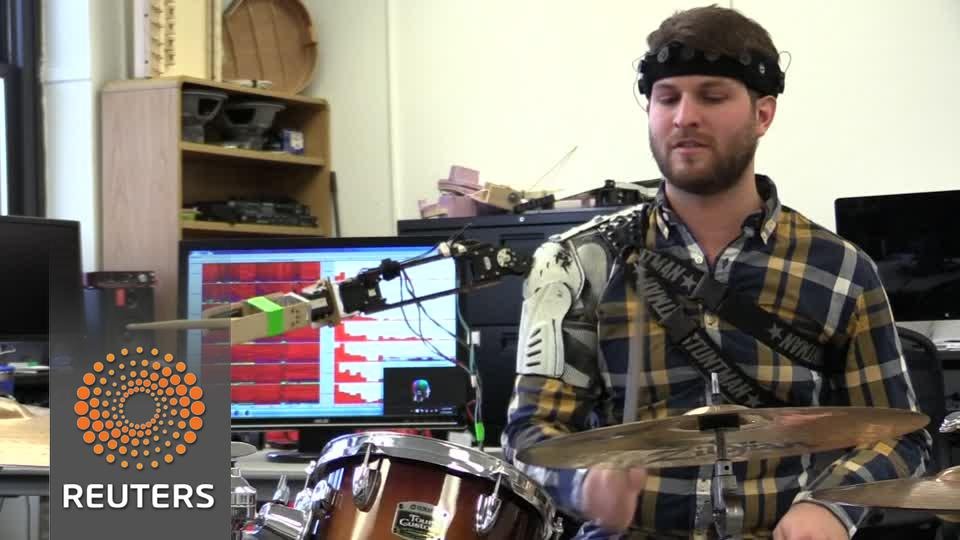
A wearable robotic limb that allows drummers to play their kit with three arms has been invented by U.S.-based researchers.
 |
A wearable robotic limb that allows drummers to play their kit with three arms has been invented by U.S.-based researchers.
The two-foot long 'smart arm' can be attached to a musician's shoulder and was invented by researchers at Georgia Institute of Technology, overseen by Professor Gil Weinberg.
An inventor of various experimental musical instruments, Weinberg said the aim of the technology was to maximize a drummer's potential, while pushing the limits of human-technology interaction.
"We believe that if you augment humans with technology humans should be able to do much more, and we thought that music is a great medium to try that," said Weinberg. "Music is something that is very timely, you really need to do things on the right millisecond. It's also very spatial, you need to go to the right places, so what better medium than to try the concept of a third arm that would augment you and allow you to do things that you couldn't before in music."
The arm has been programmed to respond both to human gestures and the music it hears, using motion capture technology. For instance, when the drummer moves to play the hi-hat cymbal the robotic arm will position itself to play the ride cymbal.
It's also programmed to respond to the music being played, adapting to beat, rhythm, and speed.
"We let the arm move to different drums by following where the drummer is and where the arm is with sensors on the arm itself. Some of them are embedded to make it oriented correctly and some of them is from afar to know the whole environment in general, and that's where based on your gestures the arm can move to the different drums that you are interested in," said Weinberg.
As well as knowing its location at all times, the smart drum is also aware of the direction and proximity of the drummer's real arms, via built-in accelerometers. On-board motors ensure the smart arm's drumstick is always parallel to the playing surface, allowing it to rise, lower or twist.
The device was originally created in order to build a robotic prosthesis for a local drummer who had lost an arm in an accident. Weinberg decided to continue the research to give everybody the potential to become a 'cyborg drummer'.
"If you want to move towards a particular drum the arm knows that because it recognizes the gestures and moves towards the arm and it's important that it will be there because the drums are there," he said. "You're playing with the drums and you feel like your own body is responding to you in a way. So the idea is that machines are not separated from humans, but they are becoming part of humans."
The researchers are now working on linking the arm's movements to brain activity via an electroencephalogram (EEG) headband that detects a drummer's brain patterns. They hope to identify patterns that allow the arm to react when the musician thinks about changing tempo or instruments.
But what do professional drummers think of the idea? Simon Hanson, drummer with legendary British New Wave band Squeeze, said he thought the device could be useful to help trigger drum samples, but couldn't imagine ever using such a device himself.
"Drummers can have the effect of two bass drums by having a pedal which is double where you only have one and the mechanism will play as if it's a double bass drum. It's similar to that in a way," Hanson told Reuters. "I think because the drummer's not directly controlling it from his brain - although it looks like might be able to do that in the future, which has its own complications - it would for me be an add-on to a kit so I could trigger a sample or a different instrument. The basic drum kit is great. Two hands are okay and when I'm producing and there's other drummers playing I get them to play with one hand because I think drums with one hand sounds better in many ways."
He added: "Unless it became socially acceptable it would be, I think it would be very amusing. I think the audience would be bemused. I think your mates in the band would be quite bemused, and looking at how it works and how it operates it's quite clunky and quite ugly but then, I suppose, that could change in time."
Weinberg sees other applications for the technology, such as for surgeons or technicians.
His team consisted of music, engineering, computer science and physics researchers and their project was funded by the National Science Foundation.
(Source: Reuters)





